

News
Garden Stories
A Garden spring none of us imagined
Gardening is all about embracing change. You plant seeds and wait to see which ones will sprout. You monitor emerging spring buds to mark the time until leaf-out and see which ones were affected by Chicago’s harsh winter. And you watch as the bulbs you planted last fall emerge strongly but are not quite the color you were expecting.
This year, spring at the Chicago Botanic Garden has been all about change, and acceptance of how the COVID-19 health crisis affects how we care for the Garden—and how the Garden will look when we are able to reopen.
Only essential staff is on-site at the Garden and health and safety guidance on social distancing means big changes in the work the horticulture staff does and how we do it. Our focus is to keep the Garden alive and tend to our grounds so we’ll be ready to reopen and welcome visitors back when it is safe to do so.
Our 385 acres are a living museum, filled with plants, trees, and shrubs that are under cultivation. Like objects in any museum, plants in the Garden’s permanent collection are documented and preserved—they’re not wild. They contain valuable genetic material important as a resource for restoring extant prairies and oak savannas, breeding new plants, and protecting the biodiversity of plant communities. So we need to keep those plants alive.
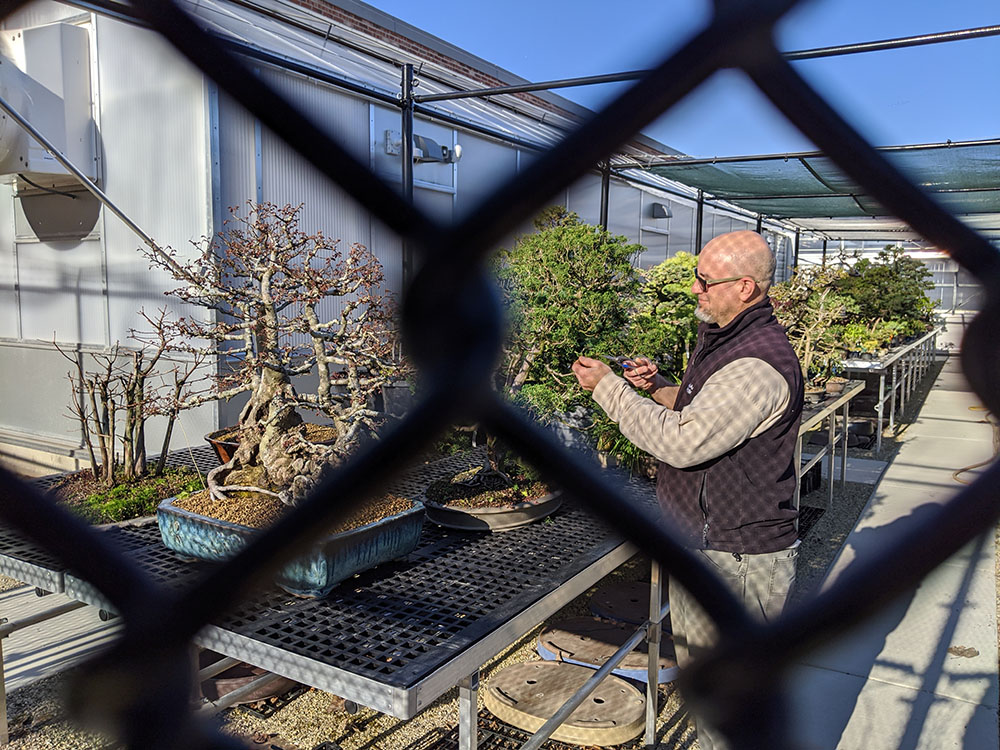
Chris Baker prunes our bonsai collection
Our Garden also features designed spaces and curated collections, in which manipulating plants through timely pruning is assumed and is essential for maintaining the design intent. Roses need proper pruning to provide the best display of flowers. For instance, the Linden Allée and the bald cypress hedge in the Heritage Garden have to have crisp architectural forms. The Scots pines in the Malott Japanese Garden must be trained annually. And every tree in our renowned Bonsai Collection requires detailed styling on an ongoing basis.
All of that has been a challenge with the closing of the Garden because of the COVID-19. The safety of our horticulture staff and valued volunteers is our priority. Gardening is all about working together in close spaces. And we rely on volunteers to help us tend to the Garden we all love—there are 1,400 volunteers who work at the Garden each year.
After the stay-at-home order was announced in mid-March, it became clear we needed to make adjustments—and quickly prioritize. We fully eliminated our spring annual displays, composting most of those annuals that typically brighten our display gardens and grounds. We downsized our plant orders to create displays for summer and fall that we could actually execute.
Once the government restrictions were in place, we adapted again. We slowly moved from a very small staff to a critical operations crew, who tend to the collections, display gardens, and plant production on the Kris Jarantoski Campus while adhering to social distancing guidelines.
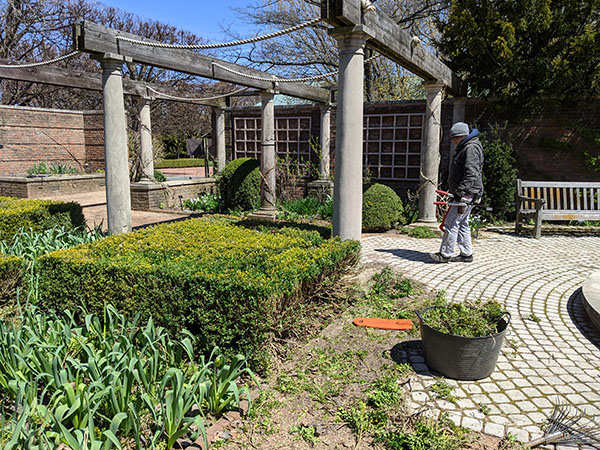
Heather Sherwood hard pruning boxwoods in the English Walled Garden
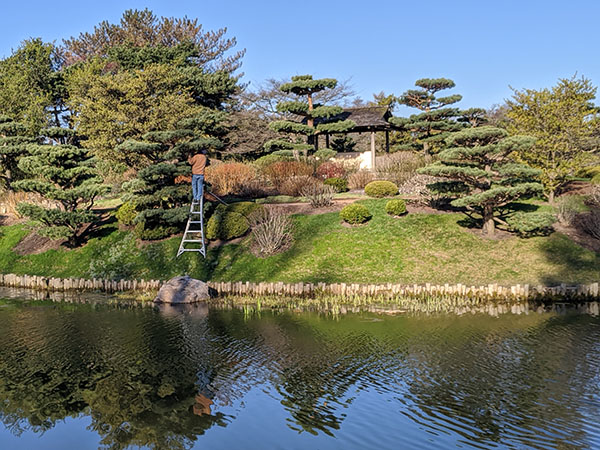
Pruning Scots pine in the Japanese Garden
Here’s a little bit of what that looks like. Senior horticulturist Tom Soulsby oversaw the removal of protective winter material from the Krasberg Rose Garden, with a reduced crew, widely spaced out. Senior horticulturist Heather Sherwood gave the boxwood squares at the Helen and Richard Thomas English Walled Garden a very hard prune to begin a rejuvenation. Each person in her small crew leaves tools out under cover, so people can avoid meeting in a cramped tool shed every day. Chester Jankowski and several other horticulturists spent part of their time in the nursery and production greenhouses, repotting plants—work that is usually done by volunteers—in order to prepare annual displays for when we can safely open.
Some of those plants will go to the Regenstein Fruit & Vegetable Garden, where horticulturist Lisa Hilgenberg has been hard at work preparing, planting, and tending to the crops that will inspire home vegetable gardeners. Vegetable starts will also head to Windy City Harvest’s urban farms for summer production.
What will the Garden look like when we do reopen? It will be different. We plan our garden designs a year ahead, and we have had to start over. In a typical year, we plant more than 150,000 annuals, and our displays feature a staggering variety sourced from numerous nurseries. That is not possible this year. We also had to rethink tasks that required working shoulder to shoulder, such as moving large containers.
Similarly, our plant production staff is innovative and resourceful. They shifted focus: What can we produce to make the Garden colorful and beautiful? What they are accomplishing is amazing. There won’t be the same kind of plant diversity that we are used to, and there may be some empty spots, but the Garden will be colorful and beautiful. And we, and our visitors, will be grateful.
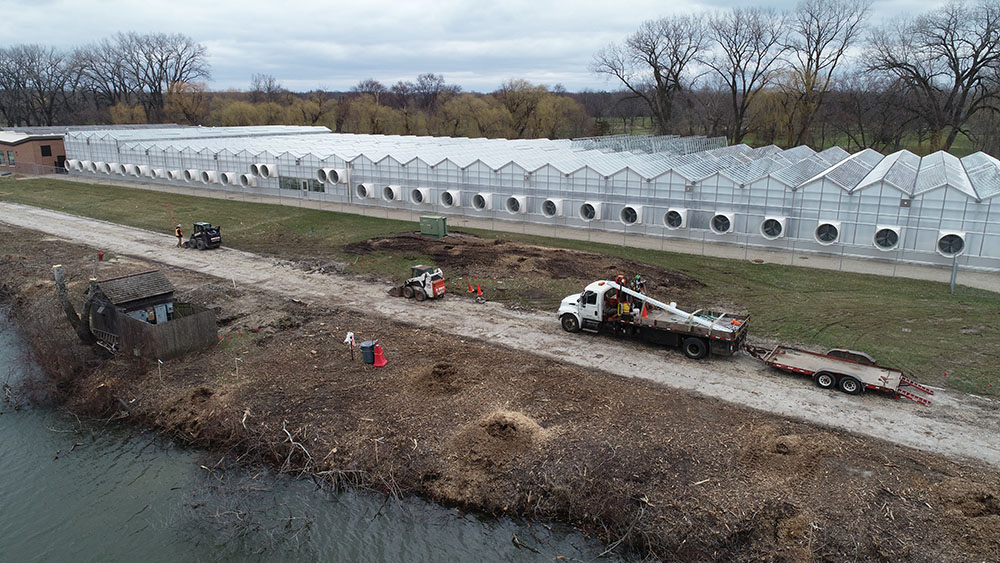
Work continues on the Mitsuzo and Kyoko Shida Evaluation Garden
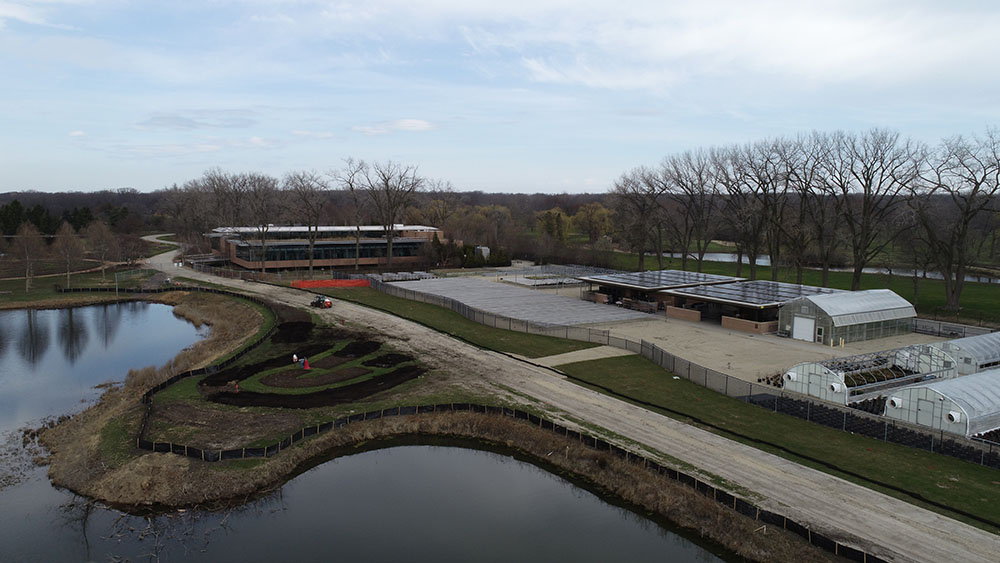
Drone photo of the Shida Evaluation Garden
There has been a bit of a silver lining to the closure. We have been able to move ahead with projects such as the Mitsuzo and Kyoko Shida Evaluation Garden and work on the path by the Thomas English Walled Garden. We’re working on the north stairs of the Regenstein Center. With fewer people to work around, we’ve been able to get some construction projects done in a more timely manner.
As a gardener, I know that plants and gardens teach us about resilience. Just like perennials that come back every year, the Chicago Botanic Garden will emerge from this closure to offer beauty and respite for our members and visitors.

